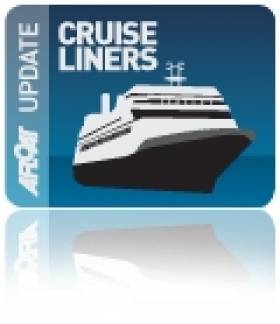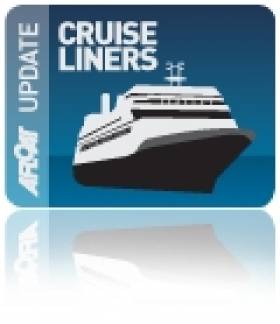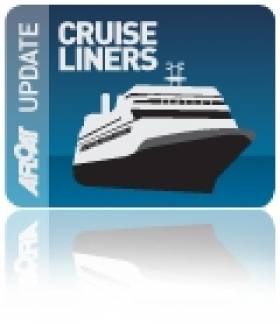Displaying items by tag: Cruiseship
Cruiseship Under 'Detention' Remains Docked in Dublin Having Arrived Almost Three Weeks Ago
#Detention - A Maltese-flagged cruiseship still remains under detention in Dublin Port having arrived in the capital almost three weeks ago, writes Jehan Ashmore.
Authorities, Paris MoU, the official body responsible for eliminating the operation of sub-standard ships (see list) detained the diminutive luxury megayacht cruiseship Variety Voyager on 1 August.
Five days previously, Variety Voyager at just 1,593 gross tonnes had according to Dublin Port website docked on 27 July. This is only the second season that operator, Variety Cruises has deployed the 2012 built ship in Irish waters. The 72 guest /36 cabin vessel is among an eclectic fleet of 8 cruiseships including sail-assisted vessels.
The Paris MoU (Memorandum of Understanding) consists of the 27 participating Maritime Authorities that agree to implement a harmonized system of Port State Control. The detention of Variety Voyages was imposed through a harmonized system of port State control. Ireland is a member of the Paris MoU along with countries throughout Europe, Canada and Russia.
Originally Variety Voyager had arrived at Ocean Pier's Berth 35. The detention however led to the ship shifting berths upriver to Sir John Rogersons Quay Berth No. 8 which is designated a cruise-berth which is sited closer to the capital's city centre.
As a reference point to Berth 8's location, the restored 'Diving Bell' painted in bright orange is located close to Variety Voyager.
Coincidentally the last detained cruiseship in Dublin Port, Berlin also Maltese flagged, was berthed yesterday in the capital too.
Berlin just shy of 10,000 gross tonnes is operated by FTI Cruises. The 400 passenger capacity cruiseship was detained for three days in June. On this occasion, the 1980 built ship, yesterday occupied North Wall Extentsion, the next nearest cruise berth to Sir John Rogersons Quay.
Afloat will be monitoring as to when the cruiseship will finally make a departure.
Brand New Marina Calls to Dublin
The cruise started from Copenhagen and toured several ports in Norway from where the vessel continued to Lerwick, Torshavn,Iceland, Portree and her last port of call was Belfast. The vessel had berthed in Dublin's Alexandra Basin and departed this evening bound for Dover.
Following the Marina's departure out of Dublin Bay via the North Burford bouy, was the Marco Polo. The 1965 built vessel operates for Cruise and Maritime Voyages and she proceeded past the South Burford bouy bound for St. Mary's, the capital of the Scilly Isles.
There will be many more cruisecalls such as the ultra luxury six-star Silver Cloud which is due on Sunday. The 16,927 tonnes vessel operated by Italian owned SilverSeas Cruises, has only a capacity for 294 passengers. Following that visit P&O Cruises 115,000 tonnes Azura docks in the capital this day next week to disembark up to 3,500 passengers. To view a full list of cruise callers click HERE.
Seasonal Scenes Set for Fishguard
Fast-ferry Stena Lynx III departed Dun Laoghaire for Fishguard Harbour on a repositioning voyage today, writes Jehan Ashmore.
The 80m craft built in Hobart, Tasmania is due to dock at the Pembrokeshire port this afternoon in advance of seasonal sailings on Stena Line's Fishguard-Rosslare.The Stena 'Express' fast-ferry service is to resume in just over a fortnight's time. Sailings are scheduled to a daily single round trip between 1 July-4 September.
The 627 passenger / 120 car capacity fast-ferry will operate in tandem with the year-round operated conventional ferry-service served by the Stena Europe. Passage times are 120 minutes for the fast-ferry service while the Stena Europe takes 3 hours 30 minutes to sail across the St. Georges Channel.
In the same week that the fast-ferry takes up summer sailings from Fishguard, the small French flagged cruiseship Le Diament is to make the first of three calls in July and once in August.
The motoryacht-like vessel which can accommodate 226 passengers is the first cruise caller of the season and is run by the only French-owned cruise operator Compagnie De Iles Du Ponant.
Former Soviet-Bloc Liner Continues Cruising
Cruising off the east coast of Leinster this evening is the veteran cruiseship Marco Polo which is bound for the Scilly Isles off Land's End, writes Jehan Ashmore.
For those with an appreciation for the more traditional tiered deck profile compared to the bulky new giant cruiseships, the 22,080 tonnes vessel built as the Aleksandr Puskin at the Mathias-Thesen-Werft, East Germany, certainly represents a different era.
The liner entered service in 1966 with the Baltic Shipping Company on their regular trans-Atlantic Montreal-Leningrad service. In 1975 she was converted for her new role as a full-time cruiseship. For a cut-away deck profile and description of facilities click here.
She can take 850 passengers accommodated in 450 cabins. Her main dimensions reflect her ocean-going design noting her draft is 8.2m (26.9ft) with a length of 176.3m (578.4ft) and a beam of 23.6m (77.4ft). Crewing is divided between senior officers (international) and cruise staff and entertainers are both British and comprising of other nationalities.
In recent years Marco Polo served the German market but she now is run by Cruise & Maritime Voyages (CMV) on cruises from the UK. The company also operate the Ocean Countess which first started out her days as Cunard Countess.
A Former Royal is Set to Return
At 6,000 tonnes, the luxuriously appointed expedition cruiseship caters for only 132 guests. She is designed to explore remote waters and with an ice-strenghtened hull she can provide destinations that include the polar ice-caps. Shore-based excursions from the ship are taken by a fleet of Zodiac-craft to transport passengers to isolated locations.
Onboard the Bahama-flagged vessel, passenger can browse in the boutique, sip a drink in the internet café, enjoy a full-service spa, take a beauty treatment in the salon, get fit in the gym or take it easy in the sauna. Plus there's live-evening entertainment and not forgetting the two top-deck whirlpools.
For a vessel of this size her facilities are comparatively impressive to the large cruise giant's such as the Grand Princess. She became the first cruiseship to measure over 100,000 tonnes when she made an inaugural call to the capital in 2004.
Nearly 300m long the vessel is the equivalent in length to three football pitches. The ship may not actually feature a playing pitch though she does have a nine-hole putting golf course!
Mega-Yacht Cruiseship Le Boréal Visits Dublin
At 142m long she was built by the Italian Fincantieri shipyard and can take 264 guests in 132 luxury cabins and in public spaces the interior has a distinctly French flair from the hand of designer Jean-Philippe Nuel. She is flagged in the Wallis Futuna Islands in the Polynesian French island territory in the South Pacific.
The vessel has a cruising speed of 16 knots and a crew of 139 look after her guests throughout six decks. On the top deck named Le Paris Deck an open-air bar is located aft and forward is a sun deck area. Below on Le France Deck there is a swimming pool, grill restaurant, internet station, library panoramic lounge and an adjoining open-decked forward facing terrace sited above the bridge.
On the Le Normandie DecK there is a fitness beauty corner, a massage, hair salon, leisure area and an image & photo desk in partnership with Philippe Plisson, synonymous for his dramatic scenes of Breton lighthouses. The photographer is based in La Trinité sur Mer for more click here.
The next deck is the Le Lafayette Deck which is predominately occupied by 35 Prestige staterooms each featuring private balconies and located aft is the theatre. Going down another deck is the Le Champollian Deck where there is the main lounge, shop, reception desk, excursion desk and a medical center. Finally we reach Le Liberté Deck where guests can dine at the gastronomic restaurant, the Marina.
Twenty three years ago Compagnie du Ponant was founded by her owners the CMA CGM Group, the world's third largest container shipping group. The cruise company is an integral part of French maritime heritage and owes its origins to the renowned Compagnie Générale Transatlantique French Line.
First Cruise-Caller of the Year
Onboard the ship which caters mostly for the UK market, asides the interior facilities there are the outdoor leisure amenities located on the Lounge Deck which has two jacuzzis and an exercise pool. There is also a large swimming pool and weather permitting a poolside buffet is also available at meal times. In addition a circular pool is located on the Marque Deck.
She alongside sister Black Watch belong to a four-ship fleet of the Norwegian owned company. Boudicca was built in 1973 and for many years served as Royal Viking Star as part of a trio of German built sisters for Royal Viking Line. The 205m long vessel underwent her last major refit in 2006.
Boudicca will remain berthed in Dublin's Alexandra Basin until she sets sail later this afternoon for the short overnight cruise-leg to Liverpool.
Last year Dublin Port handled 88 cruisecalls and this number of cruise-callers is to be closely repeated in 2011. Overall there will be over 200 cruise calls with around half a million passengers and crew scheduled to visit ports and anchorage locations throughout the island of Ireland. The cruise sector business is estimated to generate €60m to both the northern and southern economies.


































































